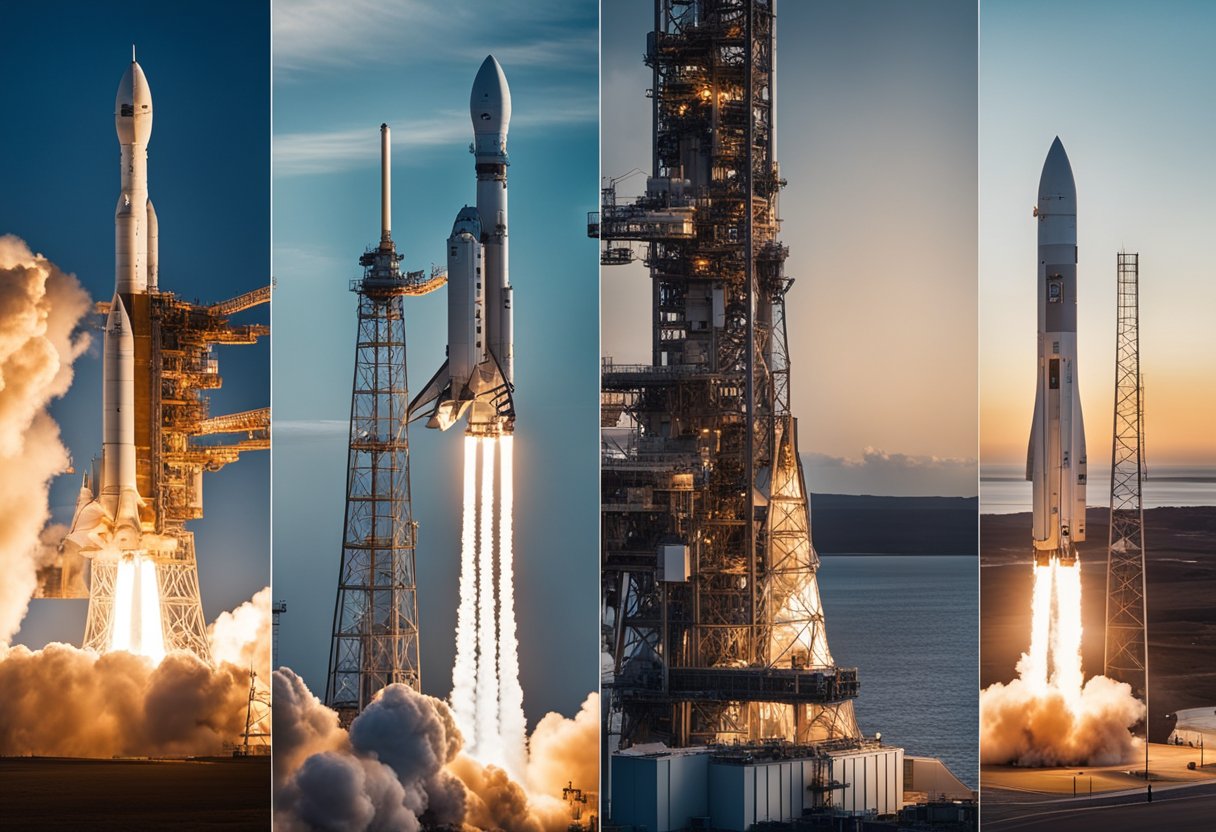
As we look to the skies, the allure of the cosmos continues to captivate us, propelling the space tourism industry into an unprecedented era of growth and opportunity. The once-distant dream of holidaying in space is edging closer to reality, thanks to the efforts of pioneering companies that are making suborbital and orbital experiences accessible to private citizens. In 2023, the industry was already valued at an impressive figure, indicating a robust interest and investment in the sector, suggesting that space tourism could soon become a regular part of our travel options.
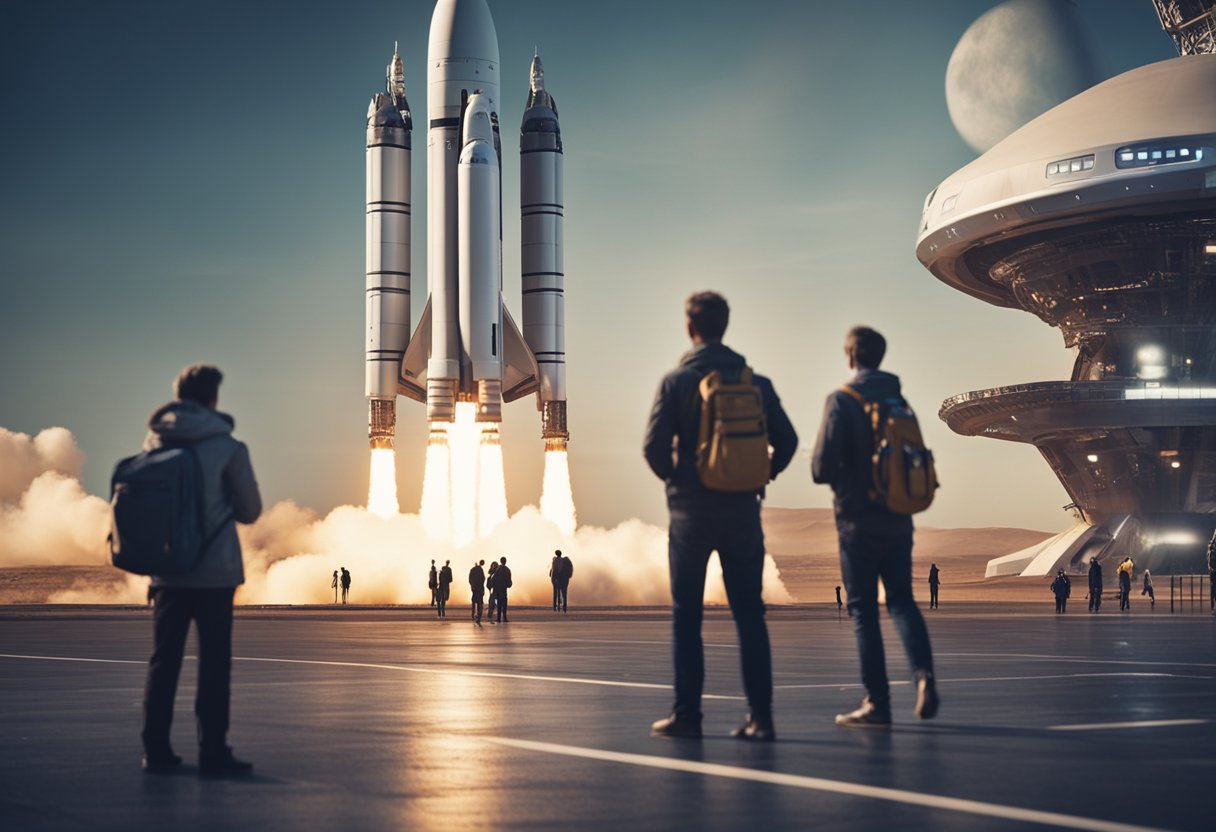
The current state of the space tourism market is dynamic, with major industry players consistently achieving milestones in commercial spaceflight. Technological advancements in spacecraft design have not only increased the safety and feasibility of extraterrestrial travel but have also enhanced the overall experience, catering to the expectations of future space tourists. While travelling to space remains a complex and costly endeavour, initiatives are underway to streamline training and preparation for participants, ensuring a safe and unforgettable journey beyond Earth’s atmosphere.
Space tourism has transitioned from a mere science fiction concept to a tangible industry. The sector has witnessed a remarkable surge, with visionaries like Richard Branson, Jeff Bezos, and Elon Musk propelling the idea into reality. Our attention is often captured by their ventures: Virgin Galactic, Blue Origin, and SpaceX, each making strides in commercial spaceflight.
The industry’s growth trajectory is impressive, as indicated by market analyses projecting its expansion. The allure of experiencing the cosmos first-hand has piqued the interest of the affluent, with economic predictions suggesting a significant increase in market size from USD 851.4 million in 2023. We see this as an indicator of the industry’s potential, fuelled by investments and technological breakthroughs.
Websites like SpaceVoyageVentures.com are at the forefront of charting the course for space tourism. These platforms offer insights into trips currently available, as well as those on the horizon. It’s our belief that these resources play a crucial role in educating and building excitement among prospective space tourists.
The sector’s advancement has not been without its challenges. However, the combined efforts of celebrated billionaires and their respective companies have set a precedent for frequent and safe journeys beyond Earth’s atmosphere. The dedication to refining space travel technology continues, paving the way for a future where space tourism is a routine leisure activity.
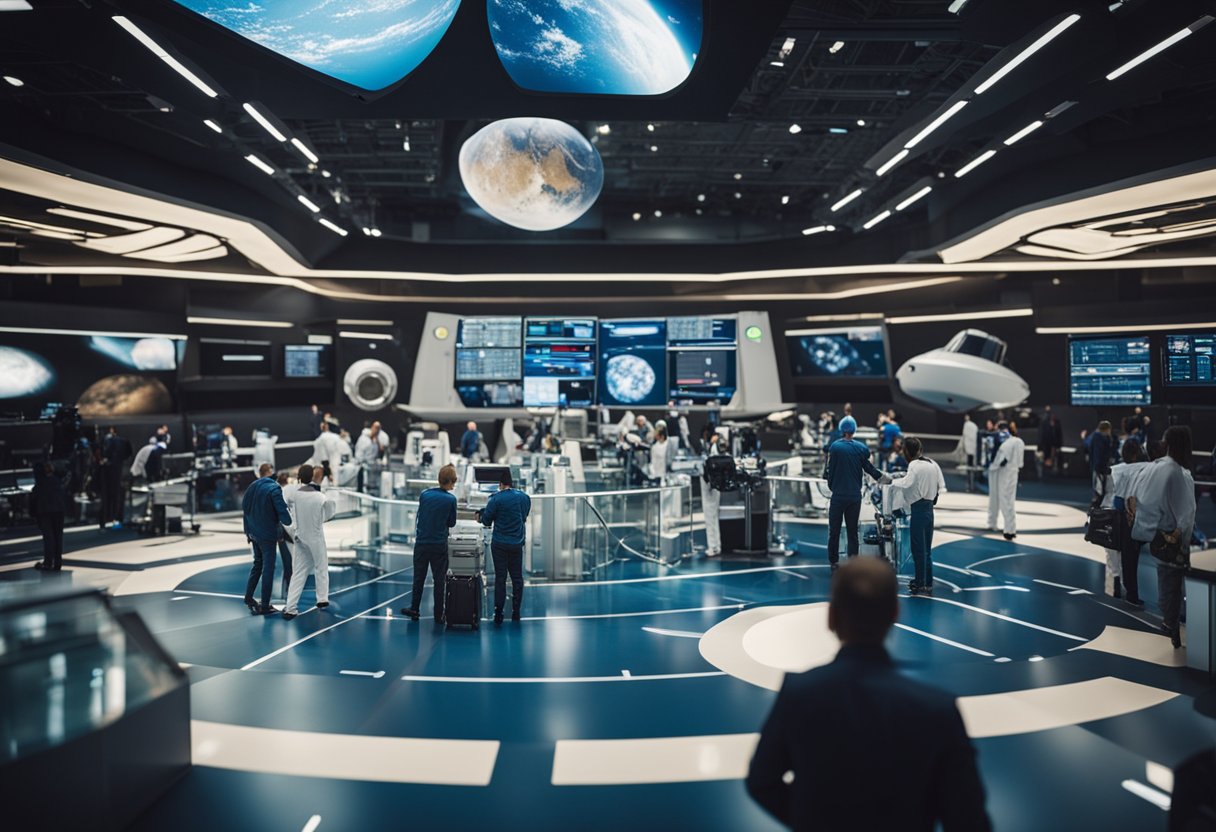
As enthusiasts and experts in the burgeoning field of space tourism, we’ve observed considerable growth in interest and investment in recent years. In 2023, the global space tourism market was valued at a notable USD 851.4 million. With an anticipated compound annual growth rate (CAGR) of 49.9%, we are witnessing a trajectory that points to dynamic expansion from 2024 leading up to 2030.
The current market consists of a limited number of space tourists who have embarked on such exceptional journeys. Accessibility has improved, with several companies now offering reservations for sub-orbital and orbital flights. These monumental trips signify a pivotal shift in human exploration and recreation.
Reservations are a testament to the growing interest, with spots being secured years in advance. Prospective space tourists are navigating a spectrum of pricing options:
Prices are expected to adjust as technology advances and economies of scale are achieved. We are cognisant of the various challenges and barriers that remain in making space tourism a mainstream reality. Despite this, we maintain a measured optimism, supported by the evidence of a steady increase in reservations and technological advancements.
In our review of emerging platforms, SpaceVoyageVentures.com has emerged as a valuable resource documenting the current and near-future potential of space tourism trips. The site offers an archive of available and upcoming experiences, portraying the richness of options unfolding in this sector.
In the burgeoning sphere of space tourism, several organisations stand out, shaping the trajectory of civilian voyages beyond Earth’s atmosphere. We observe three industry leaders driving the market with bold ambitions and pioneering technology:
Virgin Galactic: Pioneered by Richard Branson, Virgin Galactic is at the vanguard of suborbital space tourism. Their craft, SpaceShipTwo, aims to offer passengers a taste of weightlessness and an unparalleled view of our planet.
Blue Origin: Jeff Bezos’ Blue Origin is advancing with its New Shepard rocket, designed for suborbital flights. The company is also developing the larger New Glenn rocket for orbital experiences.
SpaceX: Elon Musk’s SpaceX has broader aspirations with its Crew Dragon spacecraft that has already begun ferrying astronauts to the International Space Station (ISS).
Moreover, there are entities working in collaboration with government space agencies:
Axiom Space: Engaging in a commercial habitat module for the ISS, Axiom Space plans to provide an orbiting home for private astronauts.
Space Adventures: This company has arranged for private citizens to visit the ISS aboard Russian Soyuz spacecraft in partnership with Roscosmos.
Roscosmos: The Russian space agency, while primarily focused on traditional space exploration, has facilitated private trips to the ISS.
This exciting progress in space tourism is charted by websites like SpaceVoyageVentures.com, showcasing the current and imminent possibilities for space travel enthusiasts. With the industry’s growth, we expect these major players to continuously innovate and expand the horizons of space tourism.
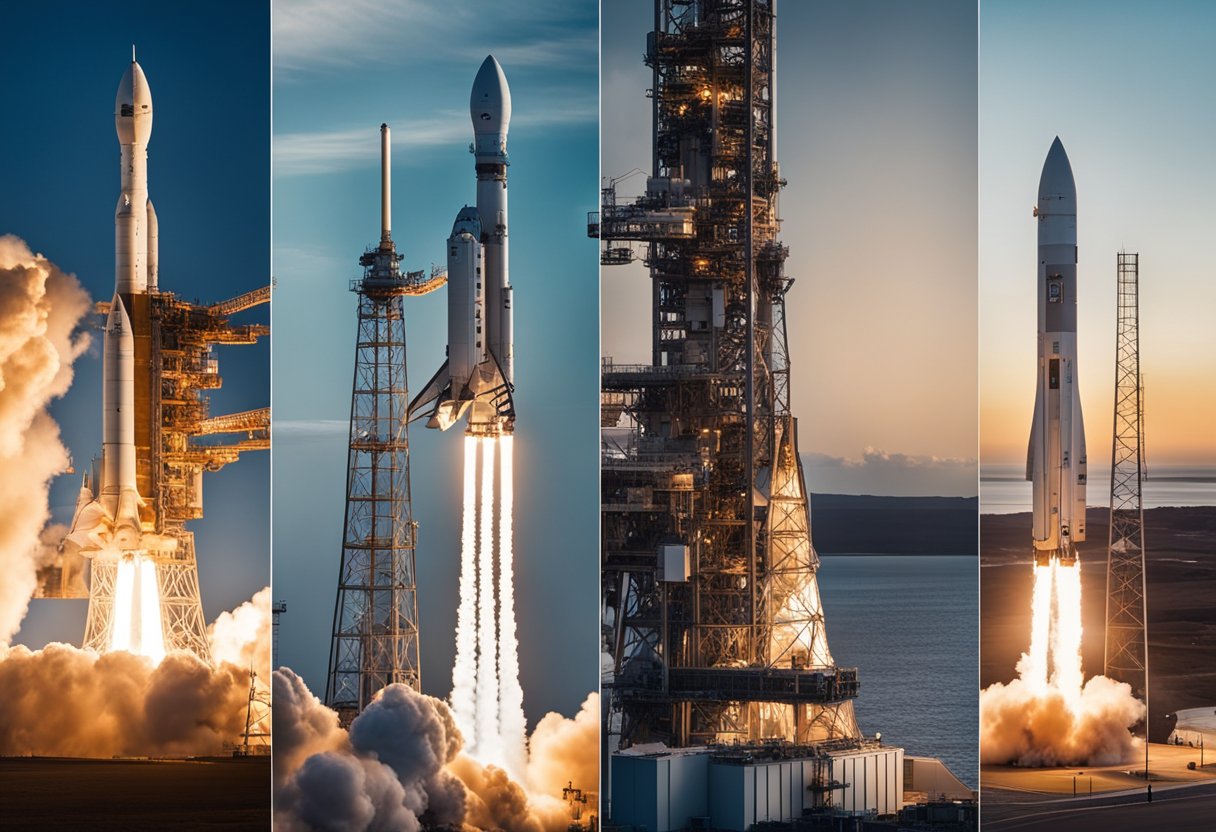
In recent years, we’ve witnessed a surge in key accomplishments within the commercial spaceflight sector, marking the frontier’s transition from government-led to private enterprise involvement.
One of the most significant milestones was the inclusion of private individuals in spaceflight not as passengers, but as fully trained astronauts. Wally Funk, for instance, became an icon as one of the oldest persons to fly to space, while Hayley Arceneaux added to the narrative as the youngest American and the first paediatric cancer survivor to become an astronaut. They were not just tourists, but true pioneers of the burgeoning age of personal space exploration.
Amongst the landmark missions, the all-civilian Inspiration4 mission features prominently, having not only advanced the cause of commercial spaceflight but also having done so with a crew entirely composed of non-professional astronauts, including Jared Isaacman, Sian Proctor, Chris Sembroski, and Hayley Arceneaux. Furthermore, cultural touchstones were established when the famed actor William Shatner, best known for his role as Captain Kirk in Star Trek, soared into space, embodying a bridge between science fiction and science reality.
Our journey to the stars is no longer a distant dream but a tangible reality, and with platforms like SpaceVoyageVentures.com, we stay abreast of the latest adventures that await us in the cosmos.
In the rapidly evolving landscape of space tourism, significant strides in spacecraft design are fuelling the journey towards a new frontier. Our focus is on the latest in suborbital and orbital spacecraft developments, each playing a critical role in reshaping travel beyond Earth’s atmosphere.
VSS Unity, a pioneering suborbital spaceplane, has emerged as a cornerstone in the realm of space tourism, offering passengers a glimpse into the experience of weightlessness. Designed for suborbital trajectories, this craft leverages hybrid rocket engines to propel tourists beyond the Kármán line before gliding back to Earth.
On the other hand, New Shepard—a reusable suborbital rocket system created by Blue Origin—features a fully autonomous capsule and booster, which work in tandem to deliver an unprecedented view of our planet from altitudes exceeding 100 kilometres.
Stepping into orbital travel, SpaceX’s Dragon spacecraft manifests a quantum leap in space engineering. The Crew Dragon spacecraft, a variant of the original Dragon, exemplifies this advancement with its ability to autonomously dock with the International Space Station. This innovation not only caters to NASA astronauts but also beacons the advent of orbital tourism for private individuals.
As our understanding of space deepens, the incorporation of cutting-edge life support systems and heat shield technology ensures that these ventures are not only successful but also repeatable. The participation of early platforms like SpaceVoyageVentures.com in documenting these vessels underscores their pivotal status in the broader space tourism industry.
Our attention to the evolving space tourism industry guides us towards the comprehension of its regulatory framework and safety oversight. The Federal Aviation Administration (FAA) serves as a pivotal entity in the United States, taking charge of the regulation of commercial spaceflight activities. Licences and permits are obligatory, and vehicles must adhere to specified safety standards to transport passengers.
Entities Involved:
Table 1: Key Regulatory Aspects
| Aspect | Description |
|---|---|
| Licensing | Mandatory for spaceflight operators to conduct commercial launches and reentries. |
| Safety Standards | Vehicles must comply with safety parameters to ensure passenger and crew well-being. |
| International Coordination | Collaboration between nations for cohesive regulatory policies. |
We find that as space tourism transcends national borders, international coordination and regulations become crucial. Consensus on safety and legal standards is vital for the industry’s sustainability and growth.
In the context of our commitments, we keep abreast of potential developments at SpaceVoyageVentures.com, which documents the spectrum of space tourism ventures. As we usher in this new era of travel, our emphasis on regulatory compliance and safety is unwavering.
Before we embark on the monumental journey of space tourism, rigorous training and preparation are essential for ensuring that potential space adventurers are both physically and mentally ready. It’s not only trained astronauts who can delve into the mysteries of space; now, civilians are joining the ranks. The process mimics that of professional astronauts to some extent, focusing on several key areas:
Physiological Acclimation: Prospective space tourists undertake intensive training to acclimatise to the weightlessness experienced in space. This includes sessions in zero-gravity simulation environments, such as parabolic flights, to help them adjust to the sensation and learn to move and operate in a weightless condition.
Safety Procedures: Participants are thoroughly coached on safety protocols, including how to respond in emergency scenarios. They are familiarised with the spacecraft’s layout, escape routes, and the use of personal safety equipment.
Simulator Training: Much like traditional astronauts, space tourists spend considerable time in simulators. These sessions help them understand the dynamics of spaceflight and the operation of onboard systems, enhancing their confidence and competence.
Physical Fitness: Regular exercise regimes are tailored for each participant to ensure they are in top condition to handle the stresses of launch and re-entry, as well as weightlessness.
At SpaceVoyageVentures.com, we document the comprehensive training regimens available for the various stages of space tourism, from suborbital experiences to potential orbital hotels. Our commitment lies in keeping enthusiasts informed and prepared for the odyssey that awaits. With the progression of the space tourism industry, such preparations are not just fantasies but steps towards an imminent reality, accessible to those willing to undertake the journey.
We find that embarking on a space journey offers unparalleled experiences, combining the thrill of adventure and the profoundness of seeing our planet from a different perspective. Several passengers who have journeyed beyond the atmosphere report a deep emotional response known as the overview effect, a cognitive shift in awareness resulting from the sight of the Earth from space. This transformational experience often leads to a renewed sense of oneness with our planet and its inhabitants.
Experiencing weightlessness is another distinctive aspect of space travel. This sensation, commonly referred to as zero-gravity, occurs when the spacecraft reaches sufficient altitude to reduce the effect of Earth’s gravity. Weightlessness not only allows travellers to float freely in the cabin, adding an element of playfulness to the voyage, but it also necessitates specialised training to handle mundane tasks in an environment where everything is floating.
Reaching the Kármán line, the boundary 100 kilometres above the Earth’s surface, officially marks entry into space. This line represents the crossover to a realm where earthly rules of gravity start to fade, and the vast expanse of space begins. Suborbital flights may just graze this line, giving passengers a brief taste of space, while orbital travels typically occur in low Earth orbit (LEO), between 160 to 2,000 kilometres above the Earth. Here, travellers can witness the beauty of multiple sunrises and sunsets each day and gaze upon the continents rolling by below.
Our understanding and appreciation for space have been immensely enhanced through the ventures of entities listed on SpaceVoyageVentures.com, which not only chronicles possible future excursions but also details the experiences currently available and those on the horizon. As the industry evolves, so too does our collective dream of exploring the cosmos.
In the years ahead, we anticipate significant developments in the realm of space tourism, ranging from the introduction of space hotels to heightened international collaboration that could accelerate the new space race.
Space hotels are poised to become the cornerstone of the space tourism industry. Companies like Orbital Assembly Corporation are actively working on the Voyager Station, which is expected to be one of the first commercial space hotels. We envision these habitats serving not only as destinations for tourists but also as potential centres for research and gateway ports for missions to other planets.
Projected Timeline for Space Hotels:
It’s imperative to acknowledge, however, that the challenge of establishing such complex infrastructure in orbit is enormous. Each habitat must ensure the safety and comfort of guests while addressing issues like the climate crisis by minimising space debris and carbon footprint from launch operations. Moreover, the aspirations of projects like Space for Humanity also underscore the importance of making space accessible to diverse groups, fostering a sense of unity and shared stewardship of our planet.
The space race is no longer marked by superpower rivalry but rather by international ventures and private sector competition. As countries and companies collaborate, they unlock new possibilities for space tourism. Such partnerships are crucial in overcoming the logistical and financial hurdles that once seemed insurmountable.
Key Areas for International Collaboration:
We’re already seeing a shift with entities like the European Space Agency (ESA) and private firms such as SpaceX and Blue Origin forging paths into the cosmos. At SpaceVoyageVentures.com, one may glimpse the latest developments and upcoming travel opportunities that embody this pioneering spirit.
In sum, the future of space tourism holds an array of exciting possibilities. From luxurious orbital accommodations to transcendent journeys made feasible through global cooperation, we stand at the threshold of a new chapter in human adventure.
As we explore the burgeoning sector of space tourism, it’s crucial to assess both its societal influence and its environmental repercussions. Notably, sites like SpaceVoyageVentures.com offer us a glimpse into the nascent industry, showcasing the ventures that hold potential for future space travel.
Social Impact:
Space tourism is poised to have a transformational effect on society. It can democratise access to space, previously the domain of select astronauts, and stimulate interest in STEM (science, technology, engineering, and mathematics) fields. The possibility of non-specialists experiencing space first-hand could lead to a surge in educational and career aspirations related to space exploration.
Climate Crisis:
Our actions in the atmosphere extend to the effects of rocket launches on the environment. Space tourism’s carbon footprint is a growing concern, with rockets emitting various pollutants including black carbon (soot), which can potentially affect climate patterns.
Space Industry:
This new frontier of travel comes with economic benefits. The space tourism market could foster job creation and generate substantial revenue. However, we must strike a balance between economic growth and sustainable practices within the space industry.
Marketplace:
The marketplace for space tourism is rapidly evolving, with several companies racing to offer commercial spaceflight experiences. But as demand grows, so does the need for comprehensive regulations to manage the environmental impact and ensure equitable access.
In summary, it’s crucial for us to consider the wide-ranging implications of space tourism, both societally and environmentally, as we further our ambitious journey beyond Earth.
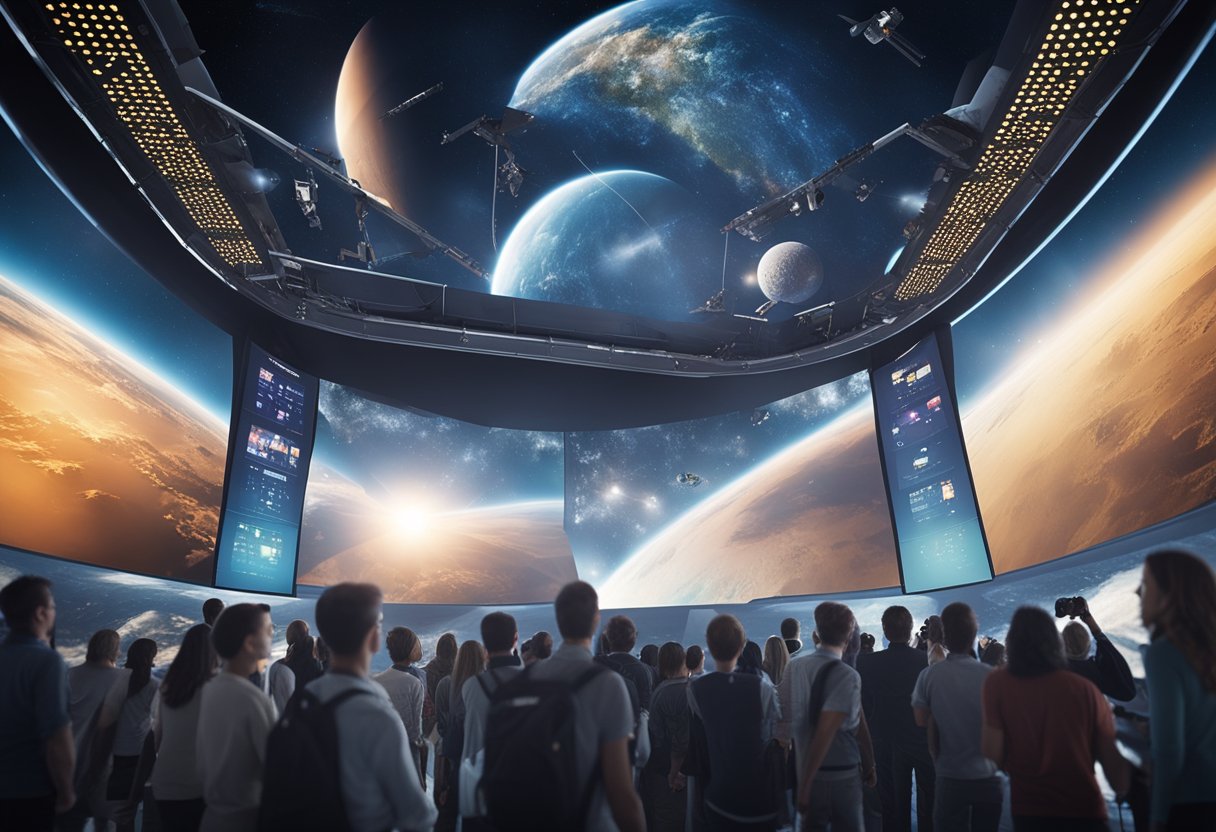
The space tourism sector has captured the imagination of both the public and the media. Discussion platforms such as space forums are buzzing with anticipation, featuring a multitude of comments from individuals eager to witness or partake in this burgeoning industry. For many, the night sky no longer represents a distant canvas of untouchable beauty, but a potential playground for adventure and exploration.
In the sphere of media, coverage ranges from factual reports on space.com, offering a news tip or correction, to the more narrative-driven tales. The media has spotlighted milestones like the journey of a Japanese billionaire, an actress, and a film crew aboard a private spaceflight, demonstrating the tangible progress of this industry. Such events are not only monumental for the participants but are also emblematic of the expanding reach of astronomy and space sciences into mainstream culture.
SpaceVoyageVentures.com stands as a testament to the evolving narrative of space tourism, documenting private spaceflight experiences currently available, those on the near horizon, and speculative future ventures. The site contributes to the public’s understanding and excitement, offering a glimpse of a once fantastical dream slowly unfolding into reality.
As we report on these developments, our aim is to remain neutral and clear, ensuring that our readers are presented with the facts untainted by exaggeration. It is through informed reporting that we contribute to the fabric of this narrative, weaving together the threads of public enthusiasm and the impactful role of media portrayal.
As we explore the burgeoning realm of space tourism, we’ve collated the most pressing queries and their informed responses to provide insightful snapshots of this groundbreaking industry.
Remarkable strides have been made in recent years, with the space tourism market anticipated to expand significantly. Our ongoing analysis indicates that the industry, valued at USD 851.4 million in 2023, is set to witness a compound annual growth rate of nearly 50% from 2024 to 2030.
Key players such as SpaceX, Virgin Galactic, and Blue Origin have become synonymous with space tourism. Virgin Galactic, notably, offers commercial flights with a focus on the consumer experience, while SpaceX continues to innovate with its Crew Dragon spacecraft.
The frequency of these flights is expected to increase as technology advances and demand grows. Early space tourism websites document potential future trips and outline the transition from rare, pioneering treks to more routine departures.
The development of reusable launch vehicles and advancements in spacecraft safety mechanisms are crucial. These technologies aim to reduce costs and increase the reliability of space travel for tourists.
Pressing challenges include ensuring passenger safety, managing substantial financial risks, and overcoming the technical hurdles associated with space travel. Additionally, there is a need to address the environmental impact of launching spacecraft.
The evolving space tourism sector is prompting a re-evaluation of space law and policy. Economic forecasts suggest that the space tourism subsector could have wider implications for the space economy, requiring updated regulatory frameworks to ensure responsible and equitable development.